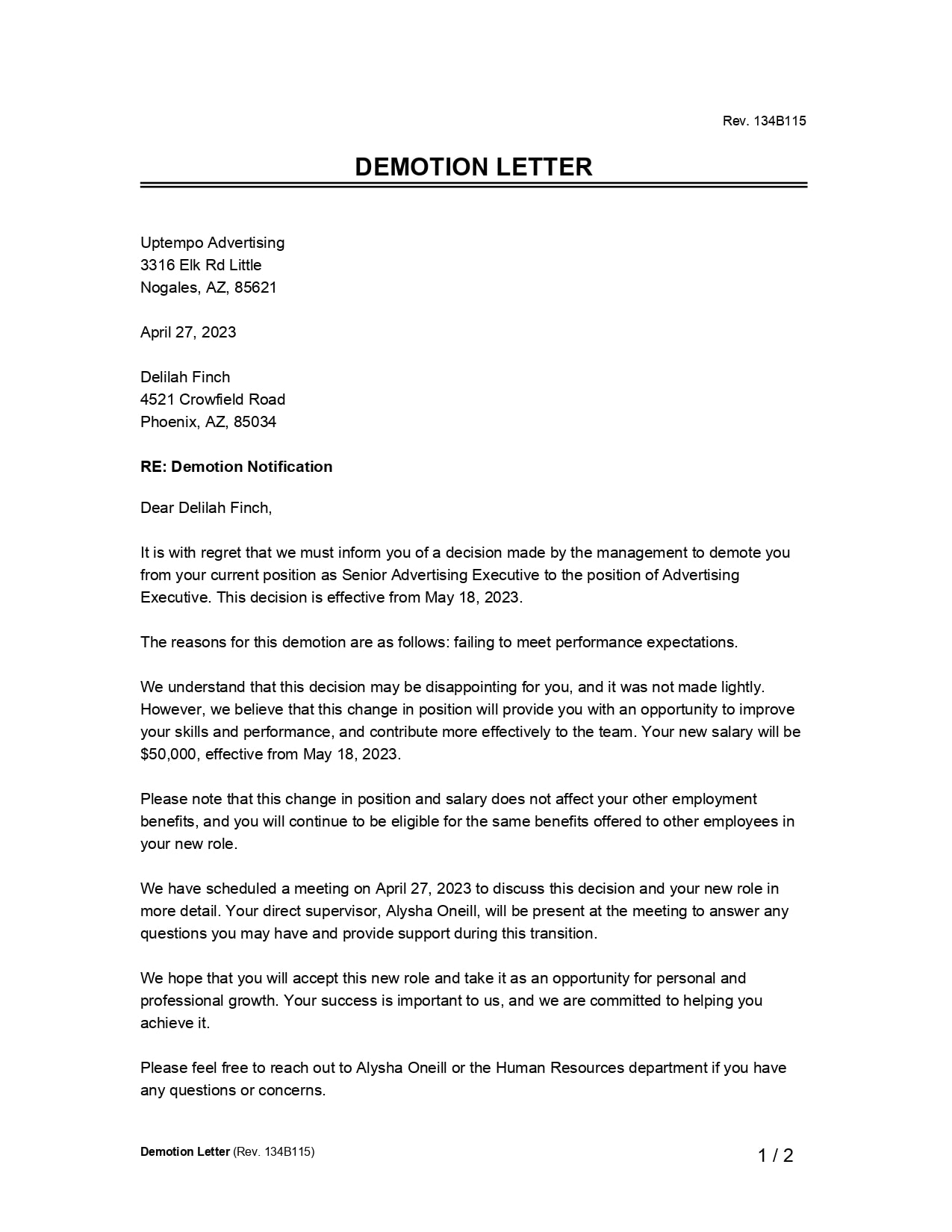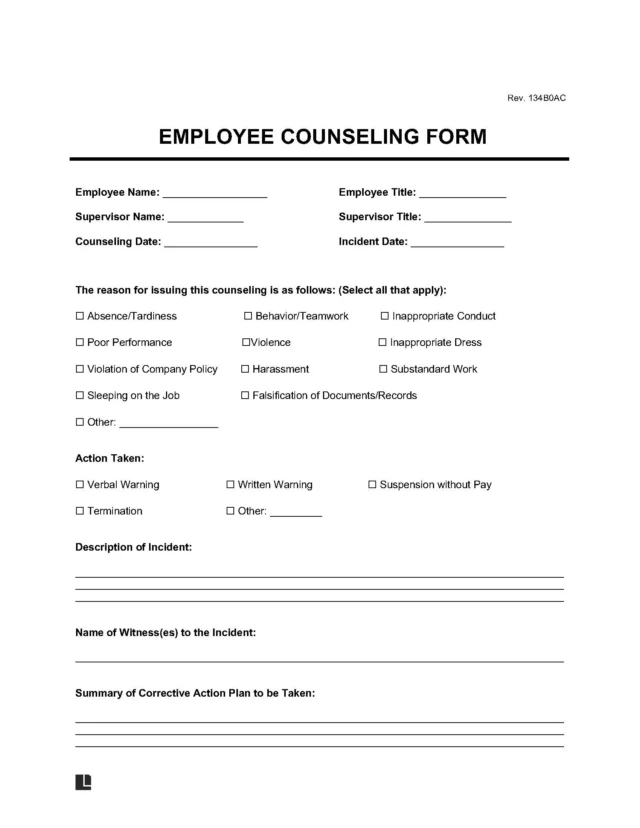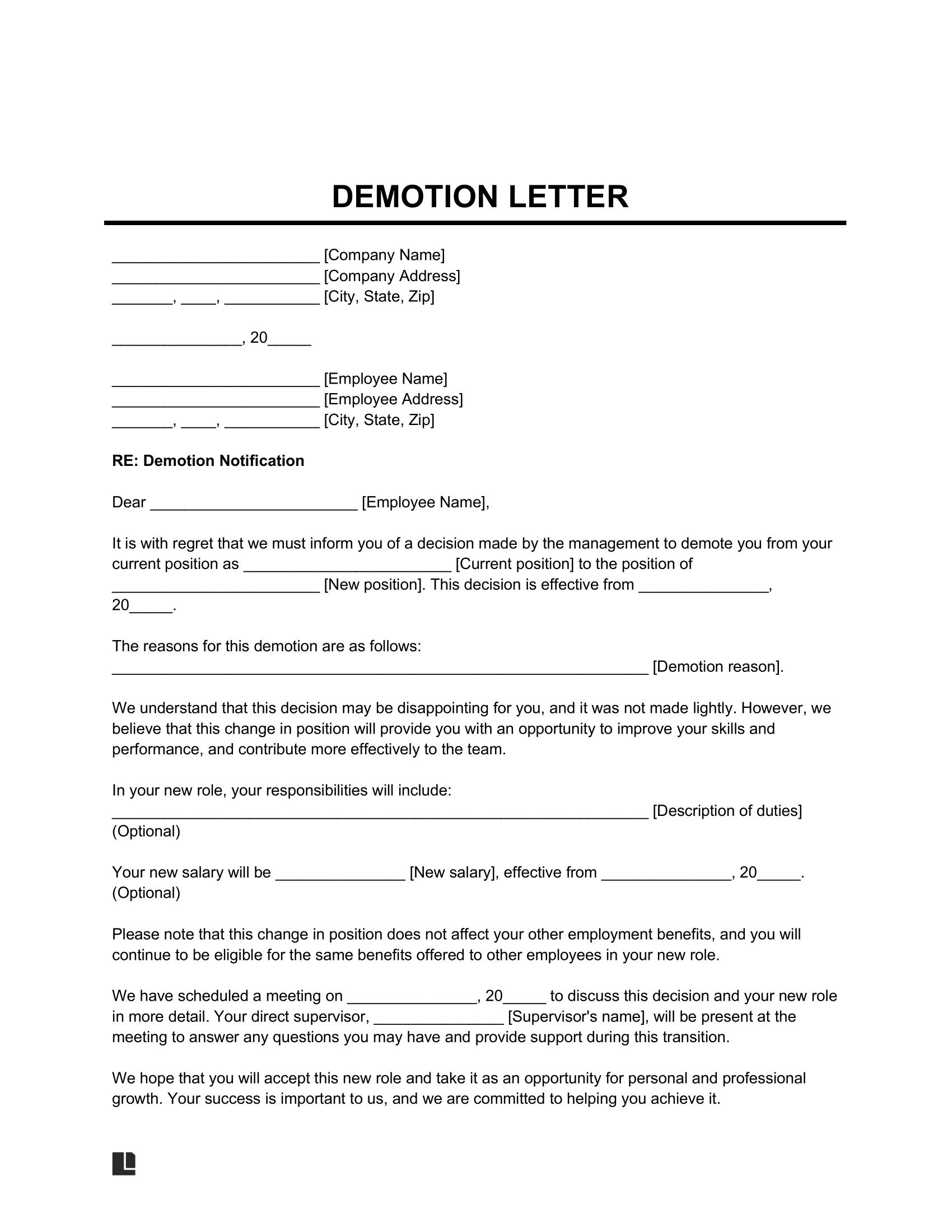What Is a Demotion Letter?
A demotion letter notifies an employee of management’s decision to lower their duties or current job title. Beyond sharing the news, it creates a formal record of the status change. This document also ensures you follow internal policies for demotions.
Use our demotion letter template to treat employees fairly and explain what’s expected next. It helps you keep things clear and support a more open, honest workplace.
When to Use a Demotion Letter
As an employer, you may need to write a professional letter of demotion to an employee for one of these reasons:
- Performance issues: Inability to meet goals or targets after a recent performance review.
- Behavior or conduct issues: Inability to remain professional or engage with internal teams respectfully.
- Poor collaboration: Inability to work with others and foster a collaborative work environment.
- Violation of company policies: Repeated violations of a cell phone policy, dress code policy, or other company policies.
- Poor leadership skills: Inability to lead others and take charge.
- Lack of adaptability: Inability to adapt to change.
- Absenteeism: Difficulty with showing up to work or being on time.
- Client dissatisfaction: Repeated complaints from customers.
- Organizational restructuring: Company downsizing or changes in team structure.
- Position elimination: Elimination of the employee’s current position.
A well-worded demotion letter communicates an employee’s status change. It allows underperforming team members to make improvements and start a new position. In their new role, they can show they still have the potential to contribute to the company’s success.
Demotion Letter Example
To better understand how to notify your employee of a demotion, use the guide below while drafting your own.


How to Demote an Employee
Managers and business owners should communicate clearly to ensure the employee knows the reasons for the demotion. They should also relay what changes to expect and their new responsibilities.
Also, creating an official record of the demotion with a formal letter may help you avoid legal complications [1] from disgruntled employees.
Whatever the reason for the demotion, a careful approach can help the employee feel valued and eager to make improvements. Take these steps:
- Document the demotion: A demotion letter serves as official documentation of the change.
- Inform the employee: A private, in-person meeting works best to notify an employee of a demotion. This gives you more control over the message delivery and lets the employee ask questions and get immediate answers.
- Involve human resources: Have a manager and HR representative present in the meeting to avoid demotion mistakes, like demoting for a minor infraction.
- Aid the transition period: Ensure everything is in place for the employee to pass on pending tasks and feel supported in the new role.
How to Write a Demotion Letter
Demoting an employee can be a challenging and uncomfortable task for employers. However, there are ways to communicate the decision that can help maintain morale and ensure transparency. To craft an effective employee demotion letter that addresses all necessary points, follow these key steps:
1. Use a Formal Tone
A demotion letter should state facts in a direct but polite tone. It should not use sarcasm, humor, or other attempts to lighten the situation.
2. Make It Clear and Concise
Much like an employment termination letter, your demotion letter should be straightforward to avoid misunderstandings that could lead to legal issues. Avoid small talk or fluff that doesn’t directly address the demotion.
3. List the Reasons for the Demotion
Provide the employee with the reasons for their demotion, such as poor performance, workplace violations, or elimination of their position. If applicable, list previous warnings, disciplinary actions, or performance evaluations that support the decision.
4. Provide a Description of the New Role
Include a short description of the employee’s role and responsibilities. Mention any changes in the reporting structure that the employee must follow. Schedule a separate meeting to discuss it in more detail.
5. Include New Salary Details
Notify your employee of how this change will affect their pay. State the person’s new salary and when the new rate becomes effective. If applicable, also mention how the demotion will impact employee benefits.
6. Explain the Next Steps
Give a clear explanation of what the employee should do next and the effective date of their new role. If you scheduled a meeting with the employee and their new supervisor, provide those details in the demotion letter.
Demotion Letter Sample
View a free sample demotion letter to employees. When you’re ready, write your own using our demotion letter template. Available in PDF and Word formats.
Handle Demotions Easily with Legal Templates
When you own your own business, you shouldn’t be wary of making demotion decisions when needed. Use our demotion letter template to inform an employee of their new position and strive toward continuous improvement. Keep things professional and make the necessary changes so your workforce can operate at its prime.
Frequently Asked Questions
How do I send a demotion email?
Write a demotion email to an employee by starting with a professional subject line, such as “New Role at [Company Name].” Maintain a positive tone and address the employee respectfully. Explain that you’re implementing a role adjustment for specific reasons. Include other details, like changes to their duties, salary, and reporting structure. Moving forward, offer to help them and emphasize that this change is for their development at the company.
How to write a voluntary demotion letter?
A voluntary demotion letter lets an employee ask for a role with fewer responsibilities. It helps them achieve a better work-life balance or work in a role that better fits their capabilities. Write this letter by asking for a position change and briefly explaining your reasons. Emphasize that you will remain committed to the company and end the letter on a positive note.
How to respond to a letter of demotion?
Respond to a letter of demotion by graciously accepting the new job title. Make the transition smoother by following the employer’s instructions. Understand that the change is for the benefit of both you and the company, and offer support however you can.






